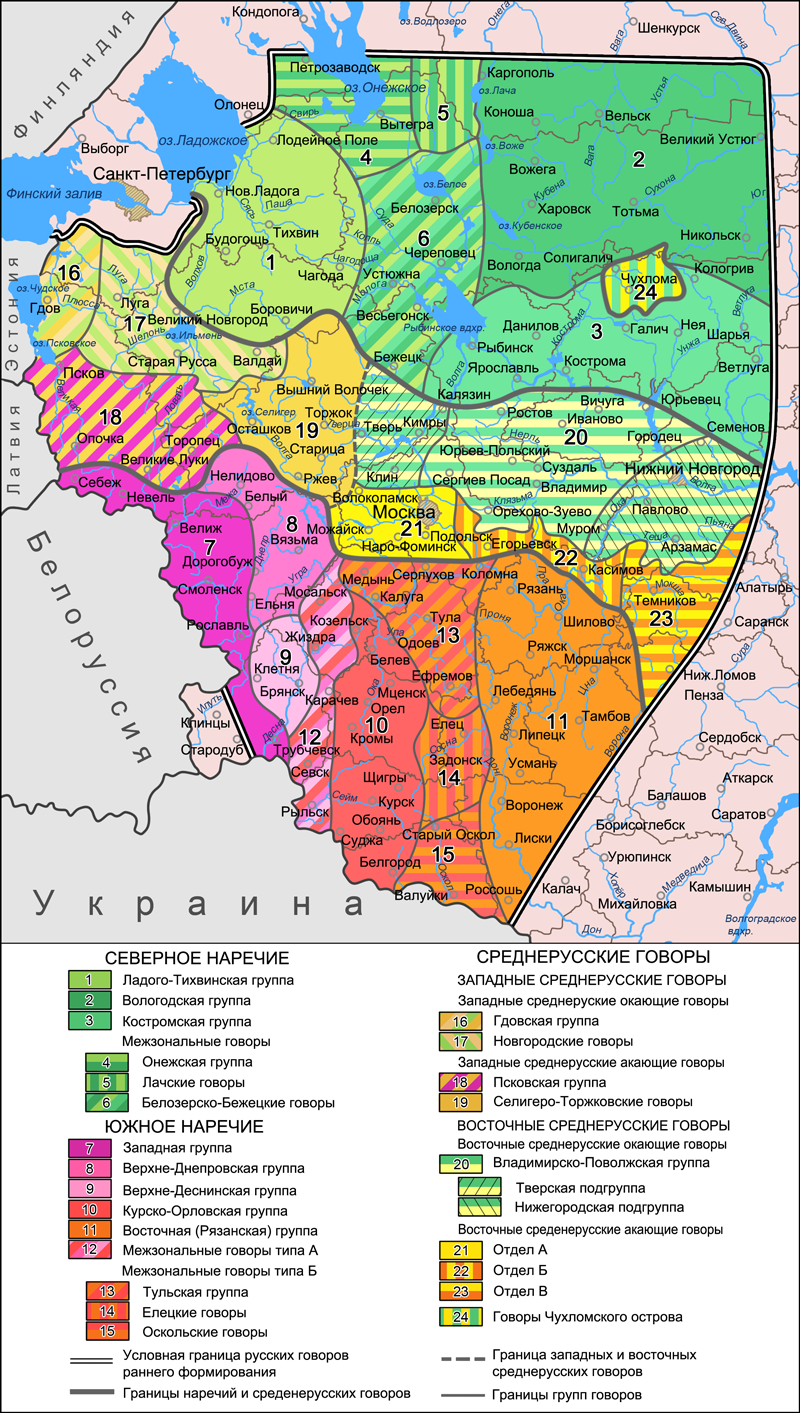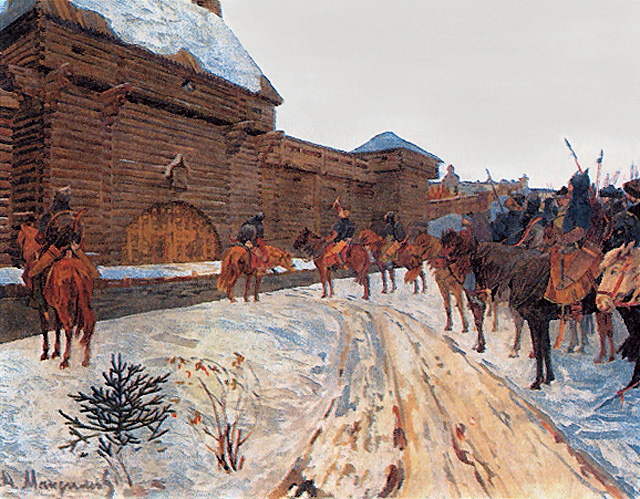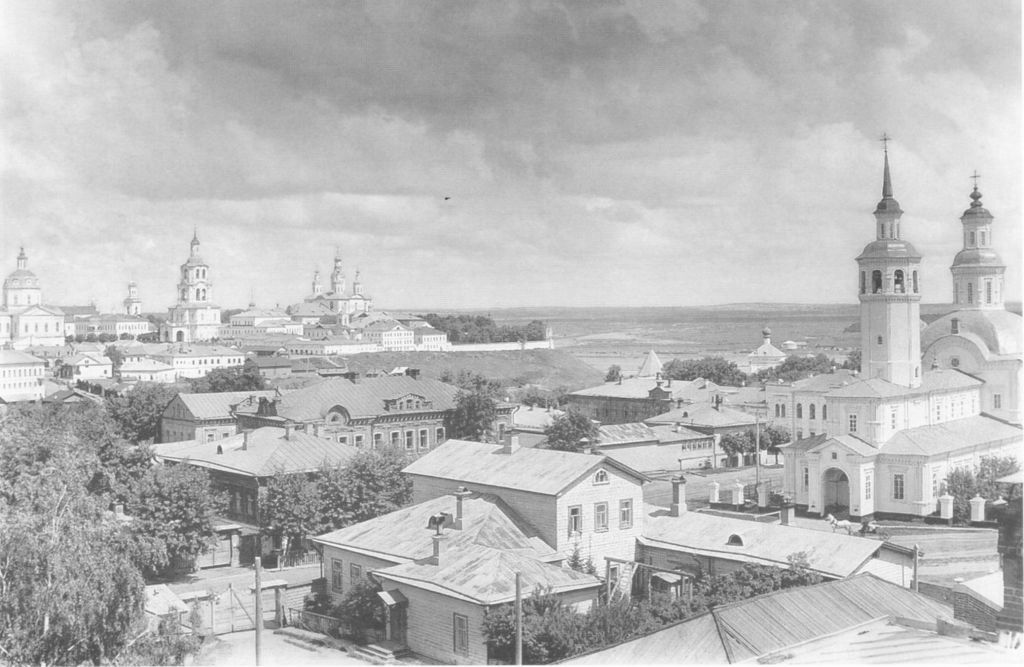|
Northern Russian Dialects
The northern Russian dialects make up one of the main groups of the Russian dialects. Territory * The territory of the ''primary formation'' (e.g. that consist of "Old" Russia of the 16th century before Eastern conquests by Ivan IV) is fully or partially modern regions (''oblasts''): Vologda, Kostroma, Yaroslavl, Novgorod, Leningrad, Nizhny Novgorod, Arkhangelsk. * The territory of the ''second formation'' (e.g. where Russians settled after the 16th century) consist of most of the land to the North and North-East of Central Russia, that is Karelia, Murmansk, Vyatka, Perm, Komi, Udmurtia, and as well as Siberia and Far East. List of sub-dialects * Pomor dialects * Olonets group * Novgorod group * Vologda- Kirov group * Vladimir-Volga group Phonology * Lack of vowel reduction: unstressed does not merge with (okanye). Unstressed , and after soft consonants also do not typically merge. * Some dialects have high or diphthongal (in the Novgorod subgroup even ) as a reflex ... [...More Info...] [...Related Items...] OR: [Wikipedia] [Google] [Baidu] |
Russian Dialects
Russian dialects are spoken variants of the Russian language. Russian dialects and territorial varieties are divided in two conceptual chronological and geographic categories: Kamusella, Tomasz. (2018). Russian: A Monocentric or Pluricentric Language?. Colloquia Humanistica. 2018. 153–196. 10.11649/ch.2018.010. # The dialects of the territory of the ''primary formation'', which consist of "Old" Russia of the 16th century (before the Eastern conquests by Ivan the Terrible) and roughly correlate with the modern Central and Northwestern Federal districts. These "historical dialects" are claimed as ethnically Russian (Russkii). # The dialects of the territory of the ''second formation'', where Russians settled after the 16th century. These new territorial varieties were produced by the Russian and Soviet imperial expansions during the last centuries and are mainly spoken by non- Slavic, non- Slavophone, and non-Orthodox populations in post-Soviet states. In Russia Depending on ... [...More Info...] [...Related Items...] OR: [Wikipedia] [Google] [Baidu] |
Pomor Dialects
Pomor dialects are a group of Northern Russian dialects spoken by the Pomors of the former Arkhangelsk Governorate and northern parts of the Olonets and Vologda Governorates. They are heavily influenced by the Old Novgorod dialect and contain a substantial number of both archaisms and borrowings from Uralic and Scandinavian languages. The Novgorod dialect spoken in Medieval Russia was the predecessor to the Pomor dialects. The Uralic people of Bjarmia changed from their own dialects to Pomor in a five-century-long process, enriching it with some Uralic vocabulary. The Pomor people were involved in trade with Norway, so they borrowed some vocabulary from the North Germanic languages too. During the Soviet period, the Pomors were compelled to shift to standard Russian. Pomor is now a dying form of speech and only a few thousand speakers remain. There is no education in Pomor, so the only way to learn it is by self study. Most parents teach their children standard Russian and n ... [...More Info...] [...Related Items...] OR: [Wikipedia] [Google] [Baidu] |
Palatalization (phonetics)
In phonetics, palatalization (, also ) or palatization is a way of pronouncing a consonant in which part of the tongue is moved close to the hard palate. Consonants pronounced this way are said to be palatalized and are transcribed in the International Phonetic Alphabet by affixing the letter ⟨ʲ⟩ to the base consonant. Palatalization cannot minimally distinguish words in most dialects of English, but it may do so in languages such as Russian, Mandarin, and Irish. Types In technical terms, palatalization refers to the secondary articulation of consonants by which the body of the tongue is raised toward the hard palate and the alveolar ridge during the articulation of the consonant. Such consonants are phonetically palatalized. "Pure" palatalization is a modification to the articulation of a consonant, where the middle of the tongue is raised, and nothing else. It may produce a laminal articulation of otherwise apical consonants such as and . Phonetically palatalized consona ... [...More Info...] [...Related Items...] OR: [Wikipedia] [Google] [Baidu] |
Veliky Novgorod
Veliky Novgorod ( rus, links=no, Великий Новгород, t=Great Newtown, p=vʲɪˈlʲikʲɪj ˈnovɡərət), also known as just Novgorod (), is the largest city and administrative centre of Novgorod Oblast, Russia. It is one of the oldest cities in Russia, being first mentioned in the 9th century. The city lies along the Volkhov River just downstream from its outflow from Lake Ilmen and is situated on the M10 highway (Russia), M10 federal highway connecting Moscow and Saint Petersburg. UNESCO recognized Novgorod as a World Heritage Site in 1992. The city has a population of At its peak during the 14th century, the city was the capital of the Novgorod Republic and was one of Europe's largest cities. The "Veliky" ("great") part was added to the city's name in 1999. History Early developments The Sofia First Chronicle makes initial mention of it in 859, while the Novgorod First Chronicle first mentions it in 862, when it was purportedly already a major Baltics-to-Byz ... [...More Info...] [...Related Items...] OR: [Wikipedia] [Google] [Baidu] |
Diphthong
A diphthong ( ; , ), also known as a gliding vowel, is a combination of two adjacent vowel sounds within the same syllable. Technically, a diphthong is a vowel with two different targets: that is, the tongue (and/or other parts of the speech organ, speech apparatus) moves during the pronunciation of the vowel. In most International Phonetic Alphabet chart for English dialects, varieties of English language, English, the phrase "no highway cowboy" () has five distinct diphthongs, one in every syllable. Diphthongs contrast with monophthongs, where the tongue or other speech organs do not move and the syllable contains only a single vowel sound. For instance, in English, the word ''ah'' is spoken as a monophthong (), while the word ''ow'' is spoken as a diphthong in most varieties (). Where two adjacent vowel sounds occur in different syllables (e.g. in the English word ''re-elect'') the result is described as hiatus (linguistics), hiatus, not as a diphthong. (The English word ''h ... [...More Info...] [...Related Items...] OR: [Wikipedia] [Google] [Baidu] |
High Vowel
A close vowel, also known as a high vowel (in U.S. terminology), is any in a class of vowel sounds used in many spoken languages. The defining characteristic of a close vowel is that the tongue is positioned as close as possible to the roof of the mouth as it can be without creating a constriction. A constriction would produce a sound that would be classified as a consonant. The term "close" is recommended by the International Phonetic Association. Close vowels are often referred to as "high" vowels, as in the Americanist phonetic tradition, because the tongue is positioned high in the mouth during articulation. In the context of the phonology of any particular language, a ''high vowel'' can be any vowel that is more close than a mid vowel. That is, close-mid vowels, near-close vowels, and close vowels can all be considered high vowels. Partial list The six close vowels that have dedicated symbols in the International Phonetic Alphabet are: * close front unrounded vowel * cl ... [...More Info...] [...Related Items...] OR: [Wikipedia] [Google] [Baidu] |
Vowel Reduction In Russian
In the pronunciation of the Russian language, several ways of vowel reduction (and its absence) are distinguished between the standard language and dialects. Russian orthography most often does not reflect vowel reduction, which can confuse foreign-language learners, but some spelling reforms have changed some words. There are five vowel phonemes in Standard Russian. Vowels tend to merge when they are unstressed. The vowels and have the same unstressed allophones for a number of dialects and reduce to an unclear schwa . Unstressed may become more central and merge with . Under some circumstances, , , and may all merge. The fifth vowel, , may also be centralized but does not typically merge with any of the other vowels. Other types of reduction are phonetic, such as that of the high vowels ( and ), which become near-close. Thus, ('to play') is pronounced , and ('man') is pronounced . General description The five Russian vowels in unstressed position show two levels ... [...More Info...] [...Related Items...] OR: [Wikipedia] [Google] [Baidu] |
Vowel Reduction In Russian
In the pronunciation of the Russian language, several ways of vowel reduction (and its absence) are distinguished between the standard language and dialects. Russian orthography most often does not reflect vowel reduction, which can confuse foreign-language learners, but some spelling reforms have changed some words. There are five vowel phonemes in Standard Russian. Vowels tend to merge when they are unstressed. The vowels and have the same unstressed allophones for a number of dialects and reduce to an unclear schwa . Unstressed may become more central and merge with . Under some circumstances, , , and may all merge. The fifth vowel, , may also be centralized but does not typically merge with any of the other vowels. Other types of reduction are phonetic, such as that of the high vowels ( and ), which become near-close. Thus, ('to play') is pronounced , and ('man') is pronounced . General description The five Russian vowels in unstressed position show two levels ... [...More Info...] [...Related Items...] OR: [Wikipedia] [Google] [Baidu] |
Volga
The Volga (; russian: Во́лга, a=Ru-Волга.ogg, p=ˈvoɫɡə) is the List of rivers of Europe#Rivers of Europe by length, longest river in Europe. Situated in Russia, it flows through Central Russia to Southern Russia and into the Caspian Sea. The Volga has a length of , and a catchment area of «Река Волга» , Russian State Water Registry which is more than twice the size of Ukraine. It is also Europe's largest river in terms of average discharge (hydrology), discharge at delta – between and – and of drainage basin. It is widely regarded as the Rivers in Russia, national river of Russia. The hypothetical old Russian state, the Rus' Khaganate, arose along the Volga . Historically, the river served as an important meeting place of various Eurasian civilizations. The river flows in Russia through forests, Fo ... [...More Info...] [...Related Items...] OR: [Wikipedia] [Google] [Baidu] |
Vladimir, Russia
Vladimir ( rus, Влади́мир, p=vlɐ'dʲimʲɪr, a=Ru-Владимир.ogg) is a city and the administrative center of Vladimir Oblast, Russia, located on the Klyazma River, east of Moscow. It is served by a railway and the M7 motorway. Population: History Vladimir was one of the medieval capitals of Russia, with significant buildings surviving from the 12th century. Two of its Russian Orthodox cathedrals, a monastery, and associated buildings have been designated as among the White Monuments of Vladimir and Suzdal, a UNESCO World Heritage Site. In the past, the city was also known as Vladimir-on-Klyazma () and Vladimir-Zalessky (), to distinguish it from another Vladimir in Volhynia (modern Ukraine). Foundation The founding date of Vladimir is disputed between 990 and 1108. In the ''Novgorod First Chronicle'', Vladimir is mentioned under the year 1108, and during the Soviet period, this year was decreed to be its foundation year with the view that attributes the fou ... [...More Info...] [...Related Items...] OR: [Wikipedia] [Google] [Baidu] |
Kirov, Kirov Oblast
Kirov ( rus, Ки́ров, p=ˈkʲirəf, a=Ru-Киров.ogg) is the largest city and administrative center of Kirov Oblast, Russia. It is located on the Vyatka River in European Russia, 896 km northeast of Moscow. Its population was 518,348 in 2020. Kirov is a historical, cultural, industrial, and scientific center of Priural'e (territory on the west side of the Ural Mountains); place of origin for Dymkovo toys; the most eastern city founded during the times of Kievan Rus'. The city also had the names of Khlynov (, from 1457 to 1780), and Vyatka (, until 1934). History Principality and republic The native Slavic tribe of Central Russia and Volga regions, the Vyatichis (also called Viatichi), mixed here with the Novgorod Slavs, Novgorodian Slovenes and Finno-Ugric languages, Finno-Ugric people. According to the medieval chronicles the first Russian settlements in the area appeared in 12th century. Kirov itself was first mentioned (as Vyatka) for the first time i ... [...More Info...] [...Related Items...] OR: [Wikipedia] [Google] [Baidu] |






